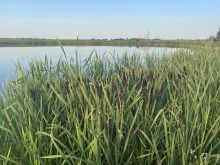Hugh Campbell fondly recalls how he discovered camelina, a crop he thinks has the potential to become Canada’s third major oilseed.
Shortly after the collapse of the
Soviet Union, he flew to Russia with a Ukrainian colleague, collecting all kinds of plant samples from the countryside.
“We went tramping through Siberia when we shouldn’t have been there, which was quite an experience. This is one of the bits of material we brought home,” said Campbell.
“I didn’t know what the hell it was when I first got it.”
Read Also

Europe holds promise for Canadian lentils
Pulse Canada is trying to help boost lentil consumption in Europe, which is already the fourth largest market.
Since then he has identified the crop as camelina, a low-input oilseed Campbell feels offers significant advantages over canola.
The Qu’Appelle, Sask., specialty seed grower spent seven or eight years increasing his supply of the crop to the point where he was able to sell small quantities of the seed to about 50 growers last year.
Unlike most crop developers, Campbell wasn’t forced to go through the lengthy variety registration process to get his product to market.
That’s because Canada’s regulatory system contains loopholes allowing certain crops to get into growers’ hands faster than others.
“The system has made exemptions where it makes sense to do so,” said Cindy Pearson, chief of the Canadian Food Inspection Agency’s variety registration office.
The three big exemptions are for hybrid corn, turf grass and food soybeans, but exceptions are also made for new categories of crops like camelina.
In the case of hybrid corn, the exemption exists because there is a requirement that all seed sold must be of pedigreed status, which means new varieties have to go through checks and balances.
“Even though it is exempt from variety registration, it really is one of the most regulated crops,” said Pearson.
Turf grass has been excluded because the merit testing component of the registration process was ineffective for a crop in which breeding advancements are measured in terms of characteristics like one line slightly greener than a previous variety.
The same goes for food-grade soybeans, which also did not mesh well with a rigid merit testing system. Breeding advancements deemed useful by end users were not seen as significant enough to warrant the granting of a new variety.
For instance, a Japanese company making miso soup might like the quality profile of a certain type of soybean, yet that trait would get rejected by the recommending committee as an insufficient breeding advancement.
Pearson said it became apparent the crop didn’t fit well into a standardized testing system.
The other exemption is for new categories of crops like camelina and marrowfat peas, which don’t fit into any of the existing crop classes already subject to registration rules.
Since they are totally new crops, there is no way to judge whether it is a breeding advancement or not.
“A new crop would initially start as being exempt and then would need to be added to the list,” said Pearson.
While crops such as camelina are allowed to go directly to market, bypassing a registration process that on average takes slightly more than three years, there are downsides to that approach.
There is no tracking and traceability for unregistered crops and they don’t come with the international trade clout of a variety recognized and approved by a government body.
Pearson said a proposal has been tabled to create a second tier of variety registration that does not have the merit requirement, which may provide a solution for dealing with the existing exemptions.















